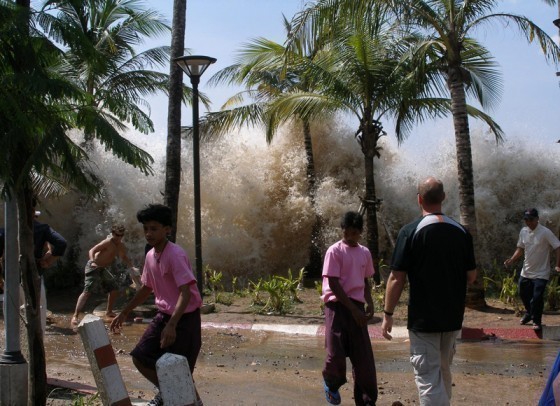Top 11 Tsunami Survival Tactics
A tsunami is a series of long ocean waves that can last up to 15 minutes and cause significant flooding, damage, and loss of life in coastal areas. Thanks to technology, many countries and areas that are susceptible to tsunamis are able to alert their respective populations when the danger of a tsunami striking exists if they are outside of the immediate area impacted by the initial earthquake which generates the tsunami waves. Recent examples of major tsunamis include the 2004 Indian Ocean earthquake generated and more recently the March 2011 Japanese earthquake which both resulted in major tsunamis. If you live in an area that can be hit by a tsunami, the following are 11 survival tactics that could prove the difference in you or your family surviving or being memorialized when tragedy strikes.
Top 11 Tsunami Survival Tactics
#1 Tsunami Survival Tactic – Observe and Heed Natural Warnings
Two of the most common natural warnings that a tsunami may be coming are earthquakes and a rapid fall or rise in coastal waters. Being inconvenience for a few hours is a small price to pay for saving your or your family’s life. Over the past 40 years, there are a number of examples of individuals ignoring drastic drops in sea level on the coast that preceded significant tsunami waves.
#2 Tsunami Survival Tactic – Expect a Number of Large Waves
The first large wave when a tsunami strikes is not necessarily the last. Many people were lost in the 1960 Chilean tsunami in Hawaii when they thought the danger was past after the first initial wave struck the islands.
#3 Tsunami Survival Tactic – Find High Ground and Stay There
Once you receive an official tsunami warning or observe a natural warning sign on your own, find high ground. Once you find high ground, plan on staying for a while until you can be sure the danger has past.
#4 Tsunami Survival Tactic – Leave Your Belongings Behind
Over the years, a number of people have lost their lives by being slowed down bringing too many possessions with them or going back to areas in the tsunami danger zone to retrieve non-essential belongings. You should take only what you can easily carry without being slowed down if the danger of tsunami is imminent.
#5 Tsunami Survival Tactic – Expect Roads to Disappear or Be Unreliable
Between the earthquakes which typically trigger a tsunami and the significant volume of water that strikes a coastal area with the large waves, most roadways will be unreliable. In many cases, the road(s) will simply be wiped away. In others, they are made unstable and potentially dangerous to pedestrian or automotive traffic.
#6 Tsunami Survival Tactic – Find the Top Floor or Roof
If you find yourself or your family trapped, go to the roof or top-floor of the closest, sturdy building. This is not as good as heading to high ground, however, if you are in “Fight or Flight” mode, flight to the highest structure you can reach can mean the difference in death or survival. The building may still collapse, however, there have been a number of tsunami survivors in the past 50 years who lived only because they followed this advice.
#7 Tsunami Survival Tactic – Climb a Nearby Tree
If there is not a building or high land nearby, then climbing a tree is better than nothing. You and/or the tree may still get swept away by the wave(s), however, your odds of survival will increase the higher in the air that you are if trapped or penned in by the wave(s). This is a last resort technique, however, with finding high ground still being the best survival tactic.
#8 Tsunami Survival Tactic – Find Something that will Float
If you get swept up by the waters from a tsunami, then look for something that will float and grab hold or climb on top of it. This can range from anything such as an uprooted tree, building rooftop, to other wooden materials. Cars and other metallic structures tend to sink eventually and are not a good option to use. If you are floating on a structure, realize that it could be up to a day later before the waters subside enough for you to become mobile again.
#9 Tsunami Survival Tactic – Expect the Land to Lower
Earthquakes that trigger tsunamis have been known to lower coastal land by up to 10 feet or more. As a result, areas that might not be susceptible to flooding at high tide, may now be dangerous to linger around. Be aware of your surroundings and do not trust the history of an area, instead relying on your or others observations of where flooding may still occur.
#10 Tsunami Survival Tactic – Expect a Lot of Debris
Tsunamis will leave behind a lot of debris to include dead bodies, animals, and other potentially dangerous substances. Do not enter structures or touch anything that looks out of the ordinary until you can be absolutely sure it is safe. Many people lose their lives or become sick in the immediate hours after a tsunami subsides.
#11 Tsunami Survival Tactic – Expect a Lot of New Friends
There will be a significant number of impacted persons after a tsunami. If you are lucky and are able to provide shelter or food, expect that you will see significantly more people than you would normally shelter on your property. With limited food or water supplies, making plans for proper rationing of your available supplies will ensure that you can aid the most people until national or international help can arrive.


Comments - No Responses to “Top 11 Tsunami Survival Tactics”
Sorry but comments are closed at this time.